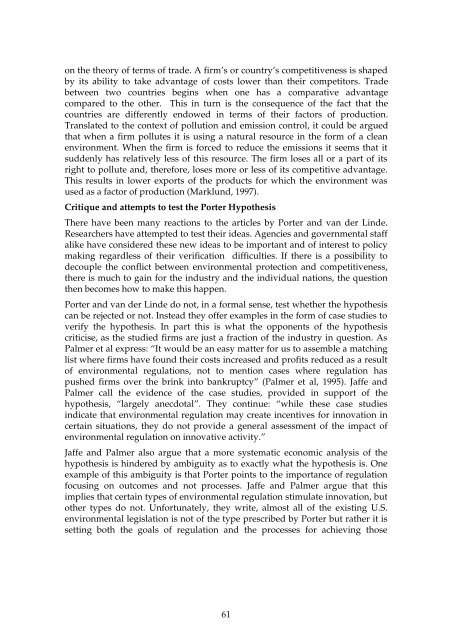Drivers of environmental innovation - Vinnova
Drivers of environmental innovation - Vinnova
Drivers of environmental innovation - Vinnova
You also want an ePaper? Increase the reach of your titles
YUMPU automatically turns print PDFs into web optimized ePapers that Google loves.
on the theory <strong>of</strong> terms <strong>of</strong> trade. A firm’s or country’s competitiveness is shaped<br />
by its ability to take advantage <strong>of</strong> costs lower than their competitors. Trade<br />
between two countries begins when one has a comparative advantage<br />
compared to the other. This in turn is the consequence <strong>of</strong> the fact that the<br />
countries are differently endowed in terms <strong>of</strong> their factors <strong>of</strong> production.<br />
Translated to the context <strong>of</strong> pollution and emission control, it could be argued<br />
that when a firm pollutes it is using a natural resource in the form <strong>of</strong> a clean<br />
environment. When the firm is forced to reduce the emissions it seems that it<br />
suddenly has relatively less <strong>of</strong> this resource. The firm loses all or a part <strong>of</strong> its<br />
right to pollute and, therefore, loses more or less <strong>of</strong> its competitive advantage.<br />
This results in lower exports <strong>of</strong> the products for which the environment was<br />
used as a factor <strong>of</strong> production (Marklund, 1997).<br />
Critique and attempts to test the Porter Hypothesis<br />
There have been many reactions to the articles by Porter and van der Linde.<br />
Researchers have attempted to test their ideas. Agencies and governmental staff<br />
alike have considered these new ideas to be important and <strong>of</strong> interest to policy<br />
making regardless <strong>of</strong> their verification difficulties. If there is a possibility to<br />
decouple the conflict between <strong>environmental</strong> protection and competitiveness,<br />
there is much to gain for the industry and the individual nations, the question<br />
then becomes how to make this happen.<br />
Porter and van der Linde do not, in a formal sense, test whether the hypothesis<br />
can be rejected or not. Instead they <strong>of</strong>fer examples in the form <strong>of</strong> case studies to<br />
verify the hypothesis. In part this is what the opponents <strong>of</strong> the hypothesis<br />
criticise, as the studied firms are just a fraction <strong>of</strong> the industry in question. As<br />
Palmer et al express: “It would be an easy matter for us to assemble a matching<br />
list where firms have found their costs increased and pr<strong>of</strong>its reduced as a result<br />
<strong>of</strong> <strong>environmental</strong> regulations, not to mention cases where regulation has<br />
pushed firms over the brink into bankruptcy” (Palmer et al, 1995). Jaffe and<br />
Palmer call the evidence <strong>of</strong> the case studies, provided in support <strong>of</strong> the<br />
hypothesis, “largely anecdotal”. They continue: “while these case studies<br />
indicate that <strong>environmental</strong> regulation may create incentives for <strong>innovation</strong> in<br />
certain situations, they do not provide a general assessment <strong>of</strong> the impact <strong>of</strong><br />
<strong>environmental</strong> regulation on innovative activity.”<br />
Jaffe and Palmer also argue that a more systematic economic analysis <strong>of</strong> the<br />
hypothesis is hindered by ambiguity as to exactly what the hypothesis is. One<br />
example <strong>of</strong> this ambiguity is that Porter points to the importance <strong>of</strong> regulation<br />
focusing on outcomes and not processes. Jaffe and Palmer argue that this<br />
implies that certain types <strong>of</strong> <strong>environmental</strong> regulation stimulate <strong>innovation</strong>, but<br />
other types do not. Unfortunately, they write, almost all <strong>of</strong> the existing U.S.<br />
<strong>environmental</strong> legislation is not <strong>of</strong> the type prescribed by Porter but rather it is<br />
setting both the goals <strong>of</strong> regulation and the processes for achieving those<br />
61

















